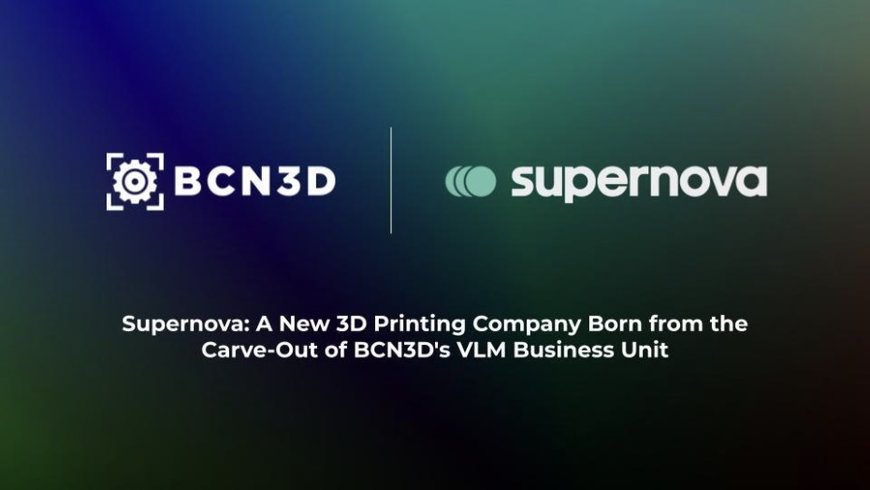Introducing Supernova: A New 3D Printing Company Born from the Carve-Out of BCN3D's Viscous Lithography Manufacturing (VLM) Business Unit, Set to Revolutionise Traditional Manufacturing with its technology
Leading 3D printing solutions manufacturer BCN3D, together with the newly formed company Supernova, have jointly announced that during Q4 2023,.

- BCN3D has carved out its VLM business unit into Supernova, an independent company incorporated in the US that begins its own path in the 3D printing industry.
- Supernova aims to unlock production applications by combining high-performance materials, a scalable production platform, and competitive cost per part, based on its patented VLM technology and proprietary high-viscosity materials.
- Supernova begins with significant market traction, with over 500 companies registering in the Technology Adoption Program, as well as key partnerships with prominent customers in the industry like Puma, Saint Gobain, Orbea, Hutchison, or Prodrive.
- Supernova’s focus in the next year will be on materials development targeting industrial applications, as well as the industrialization of the product ecosystem, with the first beta systems to be installed in 2024.
BCN3D executed a carve-out of its Viscous Lithography Manufacturing (VLM) business unit into Supernova. This new company has been incorporated in the US and will have headquarters in both Austin (Texas, US) and Barcelona (Spain). Supernova is not a subsidiary of BCN3D; instead, the two entities are completely independent, and since the carve-out, there are no further bonds between the two entities.
Supernova’s vision is to elevate products through advanced technologies, based on its breakthrough VLM technology. Supernova unlocks real production applications by providing solutions that combine quality, productivity, and a competitive cost per part.
BCN3D's purpose is to enable innovators to create the future by making industrial additive manufacturing (AM) accessible. The company focuses on enabling engineers to enhance product design through functional prototyping and to improve factory operations with tooling, jigs, and fixtures.
To be successful, each of those visions will require a distinct business model, company structure, and, most importantly, a laser-focused team. The technologies, customers, applications, and materials all differ significantly. By carving out its VLM business unit into Supernova, BCN3D ensures that each has its own space to flourish in the long term.
Supernova will be led by Roger Antunez as CEO, who previously served as the General Manager of BCN3D since 2019. Joining him as a co-founder is Marta Mico, formerly the VLM Head of Business Development at BCN3D. Additionally, Eric Pallares, the former CTO of BCN3D, will join Supernova as a Distinguished Technologist. Meanwhile, the rest of the team will remain at BCN3D, with Pol Domenech, the Sales Director, stepping up as the new General Manager.
Under the leadership of its CEO Xavi M. Faneca, BCN3D will continue to focus on its core business of extrusion-based technologies. The company aims to expand its leadership in the IDEX segment that the company created in 2016, and grow its industrial offering with products like the Omega I60, an all-in-one industrial FFF 3D printer built for the factory floor featuring IDEX technology, an actively heated printing chamber, a massive print volume, and an architecture ready for high speed.
At the heart of Supernova is Viscous Lithography Manufacturing (VLM), a lithography-based 3D printing process capable of processing resins up to 100 times more viscous than those used in traditional processes. This capability unlocks an unparalleled range of properties, bringing them closer to those of injection-molded plastics rather than typical 3D printing resins.
VLM technology has garnered significant interest in the market, evidenced by the registration of over 500 companies in the Technology Adoption Program. These companies span various industries, including Automotive, Aerospace, Manufacturing, Consumer Goods, Footwear, Audiology, Healthcare, and Defense, resulting in strategic partnerships with customers such as Puma, Saint Gobain, Orbea, Hutchison or Prodrive.
During the next year, Supernova plans to leverage the Technology Adoption Program to develop applications in key vertical markets. This initiative aims to influence both materials development and the industrialization of hardware systems, ultimately forming a production-ready ecosystem. Beta deployments in customer sites are expected during 2024. In line with these goals, the company will be expanding its R&D teams in both materials and product (or hardware, and software), as well as its business departments.
www.supernova3d.com

